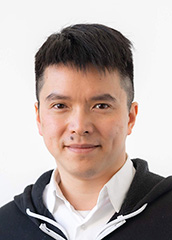Interdisciplinary learning through accessible, intentional technology
October 18, 2021
This post is republished from Into Practice, a biweekly communication of Harvard’s Office of the Vice Provost for Advances in Learning
 Hong Qu, Adjunct Lecturer in Public Policy, taught Data Visualization virtually last spring to over 70 students from different Harvard Schools, levels of experience, and corners of the world. To foster a close-knit community among students from diverse backgrounds, Qu intentionally curated a set of online tools and learning exercises to generate an “ambient telepresence.” For instance, he assigned group data visualization projects to promote peer learning and used VoiceThread for assigned peer critiques. During synchronous class time, students were invited to sketch with Qu using Jamboard on the shared screen—a novel form of participation to draw out the inner artist/designer in every student. “I wanted to give them a sense that we’re spending time with each other in this very challenging period to learn as a community, to work together on group projects, and to achieve organic connections and authentic relationships between all our unique places during this pandemic.”
Hong Qu, Adjunct Lecturer in Public Policy, taught Data Visualization virtually last spring to over 70 students from different Harvard Schools, levels of experience, and corners of the world. To foster a close-knit community among students from diverse backgrounds, Qu intentionally curated a set of online tools and learning exercises to generate an “ambient telepresence.” For instance, he assigned group data visualization projects to promote peer learning and used VoiceThread for assigned peer critiques. During synchronous class time, students were invited to sketch with Qu using Jamboard on the shared screen—a novel form of participation to draw out the inner artist/designer in every student. “I wanted to give them a sense that we’re spending time with each other in this very challenging period to learn as a community, to work together on group projects, and to achieve organic connections and authentic relationships between all our unique places during this pandemic.”
The benefits: While Qu notes that synchronous time was “irreplaceable,” intentionally incorporating asynchronous tools enhanced both student learning and community formation. Pre-recorded videos allowed students to learn technical skills and freed up precious in-class time for lively discussions and brainstorming exercises. “The tools helped a lot logistically and informationally, but they were vital in helping us coalesce as a virtual community,” he reflects. Ultimately, students felt they gained so much from his course that they requested even more coursework under Qu. This fall, the course has expanded to a sequence, with a newly added Advanced Data Visualization course for students to hone their data visualization skills.
“Any technology I’m offering in my class needs to be not just available, but accessible and prepared, for every student in a very inclusive, responsible way.”
The challenges: “Anytime you move to a new tool, you lose a portion of your students who are not going to migrate to that tool,” he cautions. To address this, Qu gives students lots of preparation and real-time instructions to ensure everyone follows along. He also offers a clear rationale for learning certain tools: “I think it’s important to have a clear explanation to justify the tools not just for the sake of using technology, but to make sure we’re all benefiting and it’s contributing to their long-term success.”
Takeaways and best practices
- Usability comes first. Qu surveyed students to ensure that a given technology was appropriate for his class. “We went out of our way to make sure the technology is appropriate and contributes to the learning process.” He notes that he will likely continue to record technical lectures to maximize accessibility for different learning styles, allowing people to reflect and rewind lectures at their convenience.
- Make sure the technology fits your learning environment. Qu suggests that assessing what technology is appropriate to incorporate in a course should be different upon returning to physical classrooms. While he was using Slack in a virtual environment, he believes that a shift to an in-person environment eliminates the need.
- Don’t overdo it! Qu notes that you can have too many tools. “Be cautious about asking students to log into three (maximum five) tools,” he warns. “It can be confusing, and the instructions can be overwhelming.” Instead, he recommends selectively choosing a few that will have the highest impact for the course based on students’ needs, material, and setting.
Bottom line: “We have to be mindful of not just the students’ backgrounds, but their level of comfort and what equipment is available to them. We don’t want to make anyone feel that they were not included or didn’t have sufficient preparation to be in class.” As a result, he underscores, “any technology I’m offering in my class needs to be not just available, but accessible and prepared, for every student in a very inclusive, responsible way.”

